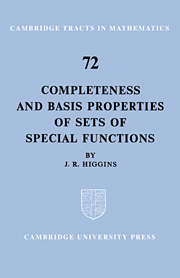Book contents
2 - ORTHOGONAL SEQUENCES
Published online by Cambridge University Press: 18 December 2009
Summary
We dealt with the theoretical aspects of bases in the first chapter, and now the reader will be anxious to see some concrete examples. Consequently this chapter and the next will be devoted to developing various methods for demonstrating completeness and basis properties, and to the application of these methods to particular examples. In the present chapter the methods are mostly designed to treat orthogonal sequences, and we leave a more detailed account of non-orthogonal sequences to Chapter 3.
2.1 Complete sequences of polynomials
Many of the standard L2 spaces, for example those taken over finite or semi-infinite intervals of R, or over R itself, have bases consisting of sequences of polynomials (pn) orthogonal with respect to a weight function w. This means that we have, for some measurable subset E of R,
∫Epnpmw = δnm,
and that we can consider either (pn) to be a CON sequence in L2(E, w), or (√(w)pn) to be a CON sequence in L2(E). Such sequences arise by orthogonalising the set of powers
{xn:n = 0,1,...}
with respect to w by the Gram–Schmidt orthogonalisation process. The completeness of the resulting set is not at once evident; consequently, we shall give a theorem in this section which guarantees completeness for suitably chosen weight functions. The uniqueness of the resulting sequence is guaranteed by the Gram–Schmidt process (see p. 117).
Information
- Type
- Chapter
- Information
- Publisher: Cambridge University PressPrint publication year: 1977
